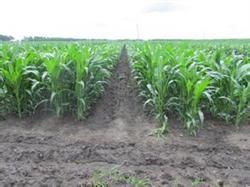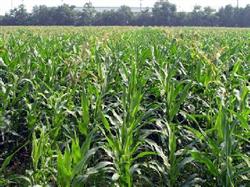Cultivation techniques of Autumn Sweet Corn in sowing period

Sweet corn fruit is fresh and juicy, also known as fruit corn, is a new type of economic corn which integrates fruits, vegetables and feed. Sweet corn is mainly fresh ears listed or processed into canned sweet corn, fried vegetables and raw food, sweet taste, deeply loved by people. Planting sweet corn has high economic benefit and good development prospect. July-August is the sowing season of autumn sweet corn, and its sowing time and cultivation techniques are as follows: 1. Strict isolation: in order to ensure the quality of sweet corn, sweet corn and ordinary corn or other types of sweet corn should be strictly isolated to prevent flour mixing. The commonly used isolation methods are spatial isolation and time isolation. The general distance of spatial isolation is more than 100m, or natural barriers such as woods and hills are used to isolate naturally. The difference of sowing time with time isolation should be more than 30 days. 2. Sowing at the right time: the sowing season arrangement of sweet corn should be considered comprehensively, such as market supply time, consumption, production season of fruit and vegetable processing plant and previous harvest time. When planting in a large area, attention should be paid to sowing in batches, harvesting by stages and listing. The latest sowing date in autumn must ensure that the temperature in the harvest period is more than 18 ℃. The autumn sowing time in our county is generally in the middle and late July, and the latest sowing date is in early August. 3. Soil preparation and application of basic fertilizer: select fields with deep soil layer, convenient drainage and irrigation and medium and upper fertility. The production of furrows should be convenient for drainage and irrigation, and drainage ditches should be dug around. 1000kg was applied in combination with ploughing and raking mu before planting the bed. In general, the width of the furrow is 125-130cm, the planting line is two rows, and the depth is 20-30cm. Re-apply base fertilizer before sowing. Sowing ditches are opened along the border, the distance of the ditch is 65cm, and the depth of the ditch is 12cm. In the sowing ditch, compound fertilizer 50kg was applied per 667m2, and calcium magnesium phosphorus 25kg was used as base fertilizer. Sowing after covering soil with 6-7cm, contact between seeds and fertilizers was strictly prohibited. 4. Planting density: sweet corn dominated by fresh food is generally harvested in the milk stage, and the growth period is relatively short, so the density should be increased appropriately according to the characteristics of the variety. General dense planting specifications are row spacing 60-65cm, plant spacing 27cm, planting 3500-4000 plants per 667m2. 5. Fine sowing: suitably shallow sowing, sweet corn generally sowing no deeper than 4cm. When the soil moisture reaches the field capacity of 60-70%, it is suitable for sowing. If the soil water content is on the low side, you can use dilute water and fertilizer to point and sow. The hole sows 2-3 seeds mixed with pesticides, and the upper part of the seed is covered with fine soil 3-4cm. 6. Chemical weeding: 50% Acetochlor emulsion 50g 100kg was sprayed evenly on the border and ditch surface with 50% Acetochlor emulsion on the day after sowing.
- Prev

Planting techniques of Autumn Maize
Autumn corn should be no-tillage and direct seeding after the middle of July. After the previous corn harvest, seize the time to clean the countryside, early sowing is the key, generally does not require deep ploughing. 1. The seeds should be dried for 2 to 3 days, and the seeds should be soaked for 4 to 6 hours before sowing, so that the seedlings can emerge evenly and neatly. Arrange the plant spacing according to the density of 3500 to 4000 seedlings of 667 square meters.
- Next

Operation and Research methods of phosphorus and potassium Fertilizer for High-yield Maize
The application effect of phosphorus and potassium fertilizer varies greatly due to the available content of soil. The application of phosphorus and potassium is beneficial to the early development of strong seedlings, strong plants and large ears, increase the ratio of grains to leaves, increase the number of grains and grain weight, which is an important condition to improve population quality. However, after the application of phosphorus and potassium fertilizer, most of it was absorbed and fixed by the soil, and the absorption and utilization rate was low in the soil.
Related
- The first cup of black tea in spring, the flavor and history of tea gardens in Kenya, Africa
- The computer can not only choose potatoes, but also grow tea rice. AI will grow winter oolong tea champion.
- It is not only the inflated tea bitten by insects, but also engraved with the four seasons tea in Beipu.
- The Oriental Beauty Tea Festival in Zhuxian County takes the stage at the weekend to experience the plus-size feast of oil tea.
- & quot; Oriental Beauty Tea & Exploration of Emei in Hsinchu, the hometown of quot;
- The new variety of strawberry "Tainong 1" dessert is the first choice with mellow aroma. Crimson gorgeous
- History of Tea in Taiwan: from Wild Inner Mountain to Export Tea Garden
- Two types of Taiwan Oriental Beauty Black Tea won the British three-Star Award for Childhood Tea Xiang Zhang Jiaqi changed from pilot to champion tea maker.
- Banana species and varieties: the planting history of Taiwan Xianren banana and dwarf banana is long, is banana disease resistant?
- Coffee planting Technology: Qianjie Coffee from Seedling to harvesting

